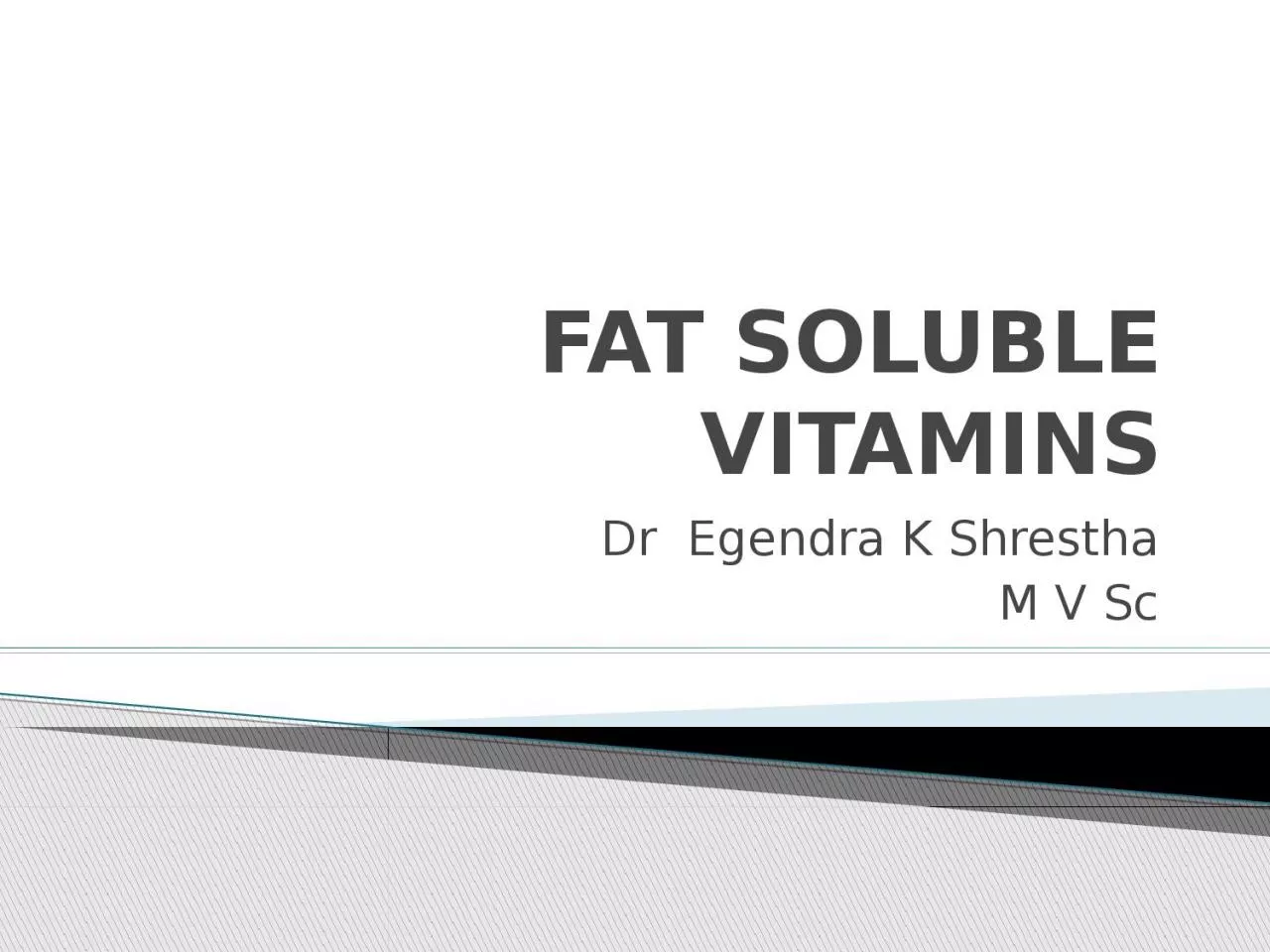

M V Sc Role of Vitamin A Synthesis of glycoprotein to maintain integrity of epithelial cells In bone formation synthesis of mucopolysacharides Synthesis of the visual pigment Rhodopsin ID: 931680
Download Presentation The PPT/PDF document "FAT SOLUBLE VITAMINS Dr Egendra K Shres..." is the property of its rightful owner. Permission is granted to download and print the materials on this web site for personal, non-commercial use only, and to display it on your personal computer provided you do not modify the materials and that you retain all copyright notices contained in the materials. By downloading content from our website, you accept the terms of this agreement.
Slide1
FAT SOLUBLE VITAMINS
Dr Egendra K Shrestha
M V Sc
Slide2Role of Vitamin A
Synthesis of glycoprotein to maintain integrity of epithelial cells.
In bone formation synthesis of mucopolysacharides. Synthesis of the visual pigment Rhodopsin. Retinol and retinoic acid (RA) are essential for embryonic development during fetal development.
Vitamin A-Retinol
Slide3Inadequate
retinol available to the retina results in impaired dark adaptation, known as "night blindness."
Mild vitamin A deficiency may result in changes in the conjunctiva (corner of the eye) called Bitot's spots. Severe or prolonged vitamin A deficiency causes a condition called xeropthalmia (dry eye) characterized by changes in the cells of the cornea that ultimately result in corneal opacity,
keratinization
of the cornea, corneal ulcers, scarring, and blindness.
Clinical signs
-Deficiency symptoms
Slide4Sometimes vitamin A deficiency can lead to obstruction of
lacrimal
ducts due to degenerated epithelial cells leading to decreased output of tears. Vitamin A is needed for bone formation. If vitamin A is deficient optic foramen is not formed properly. Small size optic foramen leads to the constriction of optic nerve. Permanent damage to the nerve can lead to permanent blindness.
Symptoms…
Slide5Infection of gastrointestinal tract, respiratory tract,
uro
genital tract and skin is common in Vitamin A deficiency. Deficiency of vitamin A can lead to infertility or sterility in male. Deficiency of vitamin A can lead to vaginitis, abnormal estrous cycle, early embryonic mortality, abortion and defective formation of
foetus
in females. Deficiency of vitamin A can lead to developmental bone deformities. Vitamin A deficiency leads to elevated
cerebro
spinal fluid (CSF) pressure results in thickened
duramater
leading to under absorption of CSF.
Clinical signs...
Slide6Calf: 1000000 to 1500000 IUCow (adult):250000
-2500000IU
Lamb :125000-250000 IUKid :125000-250000 IUSheep: 250000-500000IUPig :250000-500000IUHorse :200000-300000IU
Daily requirements
Slide7Excess- Clinical signs
Over consumption of preformed vitamin A is called
hypervitaminosis A. Symptoms include nausea, headache, fatigue, loss of appetite, dizziness, and dry skin. SupplementationOils from livers of certain fish (Cod and Halibut), Egg yolk and milk fat.
Slide8Role of Vitamin DVitamin D helps in absorpsion of Ca from the gut
Helps in proper growth of bone
Deficiency cause rickets in young animal and osteomalacia in older animalsVitamin D
Slide9Rickets
Calcium and Phosphorus deposition in bones is affected and the bones are weak, more prone to fractures and deformities.
The conditions commonly seen are bowing of legs, swollen knees and hock and arching of back. Occasionally there is paralysis. Rickety Rosary – enlargement of Osteochondral junction in ribs are also noticed.
Clinical signs- Deficiency
Slide10Resorption calcium and phosphorus from the bone that was already laid down.
Bones become weak, more prone to fractures and deformities.
It can occur in pregnant and lactating animals, which require increased amount of calcium and phosphorusDeficiency – Osteomalacia
Slide11Calf: 150000-225000 IU
Cow :adult37500-375100IU
Lamb :18750-37500 IUKid :18750-37500IUPig : 18750-37500IUHorse :6.6 IU/kgDog: 22-275 IU/kgRequirements
Slide12Toxicity – Clinical signs
Vitamin D toxicity (
hypervitaminosis D) induces abnormally high serum calcium levels (hypercalcemia), which could result in bone loss, kidney stones and Calcification of organs like the heart and kidneys if untreated over a long period of time. Supplementation
Cod liver oils (rich source),
Egg yolk and sun dried roughage/grains.
Slide13Vitamin E functions in the animal mainly as biological antioxidant.
In association with the selenium-containing enzyme glutathione
peroxidase, it protects cells against oxidative damage caused by free radicals. Vitamin E also plays an important role in the development and function of the immune system.Role of Vitamin E
Slide14The most frequent and the most important manifestation of
Vit E and
Selenium deficiency in farm animals is muscle degeneration (myopathy). Nutritional myopathy, also known as muscular dystrophy,
frequently occurs in cattle, particularly calves.
The myopathy primarily affects the skeletal muscles and the affected animals have weak leg muscles, a condition manifested by difficulty in standing and, after standing, a trembling and staggering gait.
Clinical signs –Deficiency
of Vit E
Slide15The animals are unable to rise and weakness of the neck muscles prevents them from raising their heads popularly known as
white muscle disease.
The heart muscle may also be affected and death may result.Encephalomalacia or Crazy chicks disease
Slide16Calf: 0.3-2mgLamb: 0.1-0.5 g
Pig: 0.5g
Dog: 30-100mgDaily Requirements
Slide17Green fodders,
Cereal grains,
Vegetable oils, Fats, Nuts, Oil seeds and Legumes.Supplementation
of v
itamin E
Slide18Role
of Vitamin K
Vitamin K is required for synthesis of prothrombin in the liver, which is necessary for blood clotting. Deficiency – sweet clover disease Low Prothrombin level in blood leads to hemorrhagic conditions. In cattle sweet clover disease is associated with Vitamin K.
Sweet clover contains a compound
dicoumarol, which lowers prothrombin
content of blood
.
Delayed blood clotting
during hemorrhage Supplementation
Green leafy vegetables,
Synthesized by bacteria in gastro intestinal tract.
Vitamin K
Slide19Horse and cattle: 80-250mg
Dog and cat: 5-10 mg I/m
Requirements
Slide20THANKS